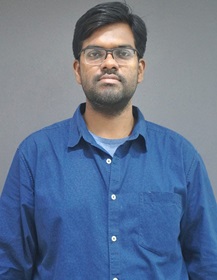
Kshitij Shakya
Assistant Professor
Department of Electrical Electronics and Communication Engineering
GITAM School of Technology
Bengaluru
Education
Ph. D.
 kshakya@gitam.edu
kshakya@gitam.edu
Kshitij Shakya is from Ujjain, Madhya Pradesh. He completed his PhD from Indian Institute of Technology Mandi, in Biomedical Instrumentation specifically cardiovascular disease detection. His work focuses on developing solutions for cardiovascular disease detection, particularly carotid artery stenosis, combining experimental validation and COMSOL simulations. He is driven by the goal of creating biomedical laboratories and fostering research in healthcare sensors and disease detection.
Research Publications
- • K. Shakya, S. Roy Chowdhury, ” A fluid-structure interaction study to analyze the severity of carotid artery stenosis at different locations and its effect on various hemodynamic biomarkers”, European Journal of Mechanics -B, Fluids
- • Shakya, K., Ahirwar, D., Nabeel, P.M. and Roy Chowdhury, S., 2022. Carotid hemodynamic response to external pressure and comparison with induced-stenosis progression: a fluid-structure interaction study. Computer Methods in Biomechanics and Biomedical Engineering, pp.1-15
- • Shakya, K., Sonker, P.K. and Chowdhury, S.R., 2019, December. A Portable Device for Measuring Heart Rate in Comparison with the Pressure Applied for Light Penetration in Skin Surface. In 2019 13th International Conference on Sensing Technology (ICST) (pp. 1-4). IEEE.
- • Shakya, K. and Chowdhury, S.R., 2022, December. A New Method to Detect the Dissimilarity in the Blood flow of Both Carotid Arteries Using Photoplethysmography. In International Conference on Frontiers in Computing and Systems (pp. 387-396). Singapore: Springer Nature Singapore
- • K. Shakya, S. Roy Chowdhury,”Modelling and Simulation of Various kinds of Blockage in Carotid Artery and Finding their Pressure and Velocity Gradient suitable for Measuring these Parameters Noninvasively with the help of External Pressure and Velocity Sensors”, Sensors and Transducers, Vol. 231, No. 3, pp. 15-24, 2019.
Expertise
-
Establishing research collaboration
-
Multiphysics modelling and simulations
-
Data Aquisition and data processing
-
Experimental and phantom analysis





 LinkedIn
LinkedIn
 Google Scholar
Google Scholar
 Scopus
Scopus
 ORCiD
ORCiD
